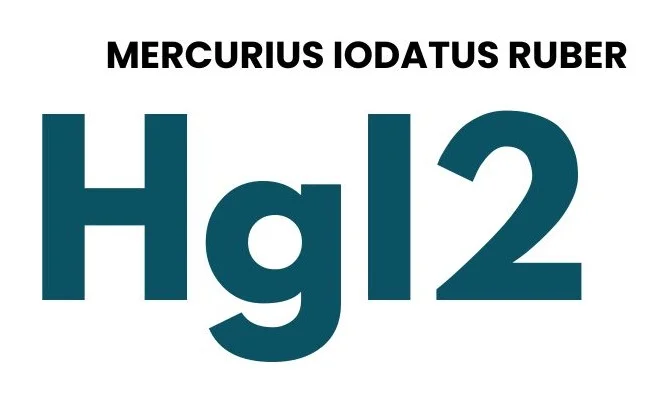Mercurius Iodatus Ruber, commonly known as the Bin-iodide of Mercury, is a homeopathic remedy derived from mercury combined with iodine.
It is primarily used to treat conditions such as diphtheria, ulcerated sore throats, chronic suppurating buboes (swollen lymph nodes), and early stages of cold, particularly in children.
This remedy is notable for its affinity to affect the throat, nasal passages, glands, and skin, particularly in cases with significant inflammation and swelling.

SOURCE INFORMATION
Origin and Historical Facts
- Derived from the combination of mercury and iodine, known for its potent effects on treating severe throat infections and syphilitic conditions.
- Historically used in traditional medicine for its antibacterial properties and effectiveness against diphtheria.
DRUG PATHOGENESIS
- Mercurius Iodatus Ruber exerts its therapeutic action primarily on mucous membranes and glandular tissues.
- It is known to reduce inflammation, resolve ulcerations, and promote healing in conditions affecting the throat, nasal passages, and skin.
- The remedy is particularly indicated when there is dark redness, swelling, and a tendency towards suppuration (formation of pus) in affected areas.
KEY CHARACTERISTICS
THROAT
- Dark Red Fauces: Throat appears dark red, and swallowing is painful.
- Phlegm in Nose and Throat: Excessive mucus in the nose and throat.
- Hawking Sensation: Constant need to clear the throat, often with a sensation of a lump.
- Stiffness of Throat Muscles: Muscles in the throat and neck feel stiff and sore.
- Diphtheria Symptoms: Severe throat infection with painful swallowing.
- Swollen Glands: Painfully swollen submaxillary glands, worse on the left side.
- Tonsillitis: Inflammation of the tonsils, often parenchymatous (affecting deeper tissues).
- Peritonsillitis: Inflammation around the tonsils, which may be prevented if treated promptly.
- Cough and Laryngeal Issues: Cough with elongated uvula, sore throat, and hoarseness (aphonia).
NOSE
- Coryza and Dull Hearing: Nasal congestion with reduced hearing ability.
- Hot Right Side: Right side of the nose feels warm to touch.
- Mucus Hawking: Constant hawking of mucus from the back of the nose (posterior nares).
- Swollen Turbinated Bones: Enlarged nasal structures causing blockage.
- Boggy Mucus Membrane: Swollen and congested mucous membranes in the nose and throat.
- Eustachian Tube Issues: Closure of the Eustachian tube, opening with a popping sound.
MOUTH
- Gum Swelling: Swollen gums with tenderness.
- Toothache: Pain in teeth, exacerbated by gum swelling.
- Swollen Glands: Enlarged glands in the mouth and throat.
- Scalded Tongue: Burning sensation on the tongue.
- Aphthous Ulcers: Painful mouth ulcers.
- Profuse Salivation: Excessive saliva production.
- Stiff Tongue: Tongue feels stiff, especially at the base, with pain on movement.
SKIN
- Fissures and Cracks: Small splits and cracks in the skin.
- Hard Papules: Firm, raised bumps on the skin.
- Hunterian Chancre: Primary lesion of syphilis.
- Syphilitic Ulcers: Ulcers associated with syphilis.
- Bubo: Painful, swollen lymph nodes.
- Sarcocele: Swelling of the testicles.
MODALITIES
- Worse: Rest, cold environment, left side.
- Better: Warmth, motion, pressure on affected areas.
WHAT ARE MODALITIES IN HOMOEOPATHY?
RELATIONSHIP WITH OTHER DRUGS
- Compare With: Plum Iod (used in mammary tumors), other Mercurius preparations.
DOSE
- Form: Third trituration (homeopathic potency).
- Administration: Typically administered in third trituration, indicating its potency and effectiveness in treating acute and chronic conditions.
Frequently Asked Questions (FAQs)
What conditions is Mercurius Iodatus Ruber used for?
- It is primarily used for treating diphtheria, ulcerated sore throats, chronic suppurating buboes, and early stages of cold, especially in children.
What are the key symptoms indicating the need for this remedy?
- Symptoms include severe throat pain, dark redness, swollen glands (particularly on the left side), and ulcerative conditions in the mouth and throat.
How should Mercurius Iodatus Ruber be administered?
- It is typically given in the form of third trituration, indicating its potent yet safe use in homeopathic practice.
Are there any specific modalities that affect its action?
- Yes, symptoms worsen with rest and in cold environments, while they improve with warmth, movement, and gentle pressure on affected areas.
Meaning of Difficult Words
- Fauces: The back part of the mouth leading to the throat.
- Coryza: Inflammation of the mucous membrane in the nose.
- Turbinated Bones: Curved bones in the nasal passage that help filter and humidify air.
- Eustachian Tube: A canal that connects the middle ear to the upper throat and back of the nasal cavity.
- Bubo: An inflamed, swollen lymph node, typically seen in certain infections.
- Sarcocele: Swelling of the testicles.
This comprehensive drug picture provides a detailed understanding of Mercurius Iodatus Ruber, its indications, characteristics, and modalities, making it a valuable reference for homeopathic practitioners and patients alike.
